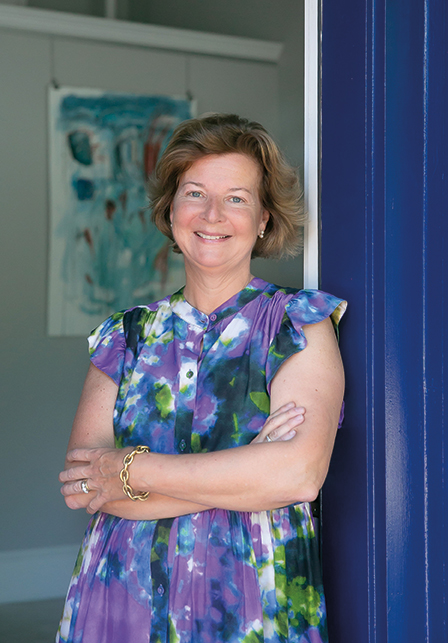Andrea Keogh ’82
 DEGREE:
DEGREE:
B.A. in history
JOB TITLE:
Gallery owner, Andrea S. Keogh Art & Design LLC
FAVORITE TRINITY MEMORY:
The wonderful people I met. Many are still my closest friends. From my first days on campus, I was struck by how genuinely nice everyone was. My freshman and sophomore years, I coxed the women’s varsity crew. We worked hard, had fun, and were undefeated. It was magical. The lessons learned on the river about teamwork and perseverance have informed my career and life.
What was your path to owning an art gallery?
The summer after my junior year, I grappled with the question of what kind of a career I wanted to pursue. I wanted it to be interesting and to incorporate my passion for art, history, and travel. Walking past a gallery in Geneva, Switzerland, I had my epiphany. I’ll become a gallerist!
My Trinity class graduated in a recession. Thankfully, two alums, Deedee Look [’81] and Angela Vorder Bruegge Hudson [’80], both worked at Sotheby’s and helped me get a summer internship. That fall, I was offered a full-time position, but I couldn’t afford to take it. Citibank hired me for an administrative role in its pioneering Art Advisory Service. It was too corporate (I hail from a long line of entrepreneurs), and I went on to work for a number of private dealers and galleries in New York and London in the old master, British watercolor, and American painting fields learning “the trade.”
My days included hours of research in art reference libraries, cataloging acquisitions, previewing auctions, and checking on art at the conservators and framers. In those days, the art business had a Wild West quality. It attracted colorful characters. The adage that sometimes learning what not to do can be more instructive than what to do certainly applied. Numerous dealers I knew went bankrupt or to jail. The most important lesson learned was to avoid debt.
Generally, working at a gallery isn’t well paid. But, if you can sell, you make commissions. A wise Italian old master dealer counseled me to start buying, too. He said, “When your own money is on the line, it makes you focus.” He was right. By 1994, I was ready to go off on my own, buying and selling American paintings from my apartment and later from a gallery space on the fourth floor of a townhouse on New York’s Upper East Side. Around 2010, collector and museum interest in American paintings waned. Ready for a new challenge, I pivoted to modern and contemporary art, opening a gallery in Litchfield, Connecticut, in 2014. Learning a new field was challenging yet rewarding. When our family relocated to Rhode Island in 2016, I acquired the smallest building in the smallest state for my business. I continue to buy and sell modern and contemporary art and added estate jewelry from the 1960s to 1980s.
What do you enjoy most about your work?
My career as a gallerist has been an adventure. I’ve been surrounded by great art, experienced the thrill of making discoveries, selling to fascinating collectors, finding and promoting talented artists, and seeing works that passed through my hands on museum walls. And I really do learn something new every day. It hasn’t been easy, but it has been wonderful.
What challenges do you face?
The only typical thing in the running of an art gallery is the sitting and waiting for people to stop in. A lot goes on behind the scenes. Keeping an eye on the markets is crucial. That means perusing endless sales online and in person. There are visits to conservators, framers, artists, and collectors. Going to museum exhibitions is important, too. Cataloging acquisitions, organizing exhibitions, hanging shows, and promoting them is essential. The biggest challenge is managing the income and the outlays. Since I buy and sell, it is always a balancing act.
How did Trinity prepare you for what you do now?
My studies at Trinity taught me to think critically, to research, and to write well.
What was the most memorable course you took at Trinity? Was there a professor who was particularly influential?
As a history major, I enjoyed almost all of my classes, particularly “European History” with Borden Painter and two courses with McKim Steele, “Imperialism” and an independent study. I had an art history class with Alden Gordon. Sadly, it was at 8:30 a.m. in a dark room after early-morning crew practice. Not a good combination. Professor Gordon has been a great supporter of my career. I regret that I didn’t major in art history. The department has a fabulous reputation and an active alumni network.
